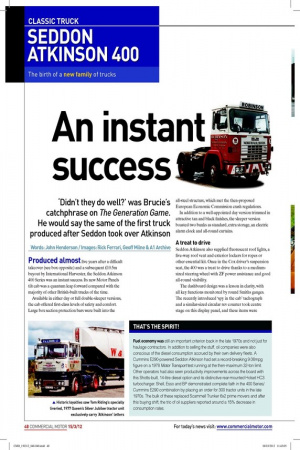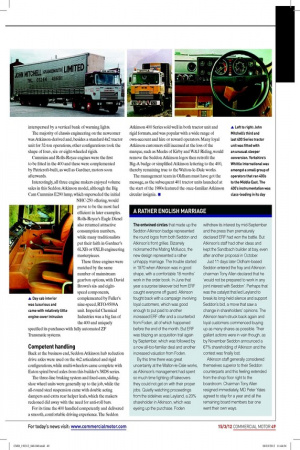SEDDON ATKINSON 400
Page 32

Page 33

If you've noticed an error in this article please click here to report it so we can fix it.
The birth of a new family of trucks
An instant success
‘Didn’t they do well?’ was Brucie’s catchphrase on The Generation Game. He would say the same of the first truck produced after Seddon took over Atkinson Words: John Henderson / Images: Rick Ferrari, Geoff Milne & A1 Archive Produced almost ive years after a dificult takeover (see box opposite) and a subsequent £10.5m buyout by International Harvester, the Seddon Atkinson 400 Series was an instant success. Its new Motor Panels tilt cab was a quantum leap forward compared with the majority of other British-built trucks of the time.
Available in either day or full double-sleeper versions, the cab offered irst-class levels of safety and comfort. Large box section protection bars were built into the all-steel structure, which met the then-proposed European Economic Commission crash regulations.
In addition to a well-appointed day version trimmed in attractive tan and black inishes, the sleeper version boasted two bunks as standard, extra storage, an electric alarm clock and all-round curtains.
A treat to drive
Seddon Atkinson also supplied luorescent roof lights, a ive-way roof vent and exterior lockers for ropes or other essential kit. Once in the Cox driver’s suspension seat, the 400 was a treat to drive thanks to a mediumsized steering wheel with ZF power assistance and good all-round visibility.
The dashboard design was a lesson in clarity, with all key functions monitored by round Smiths gauges. The recently introduced ‘spy in the cab’ tachograph and a similar-sized circular rev counter took centre stage on this display panel, and these items were interspersed by a vertical bank of warning lights.
The majority of chassis engineering on the newcomer was Atkinson-derived and, besides a standard 4x2 tractor unit for 32-ton operations, other conigurations took the shape of four-, sixor eight-wheeled rigids.
Cummins and Rolls-Royce engines were the irst to be itted in the 400 and these were complemented by Patricroft-built, as well as Gardner, motors soon afterwards.
Interestingly, all three engine makers enjoyed volume sales in this Seddon Atkinson model, although the Big Cam Cummins E290 lump, which superseded the initial NHC-250 offering, would prove to be the most fuel eficient in later examples. Rolls-Royce’s Eagle Diesel also returned attractive consumption numbers, while many traditionalists put their faith in Gardner’s 6LXB or 8XLB engineering masterpieces.
These three engines were matched by the same number of mainstream gearbox options, with David Brown’s sixand eightspeed components, complemented by Fuller’s nine-speed, RTO-9509A unit. Imperial Chemical Industries was a big fan of the 400 and uniquely speciied its purchases with fully automated ZF Transmatic systems.
▲ Day cab interior was luxurious and came with relatively little engine cover intrusion
Competent handling
Back at the business end, Seddon Atkinson hub reduction drive axles were used on the 4x2 articulated and rigid conigurations, while multi-wheelers came complete with Eaton spiral bevel axles from this builder’s 38DS series.
The three-line braking system and ixed-cam, slidingshoe wheel units were generally up to the job, while the all-round steel suspension came with double acting dampers and extra rear helper leafs, which the makers reckoned did away with the need for anti-roll bars.
For its time the 400 handled competently and delivered a smooth, comfortable driving experience. The Seddon Atkinson 400 Series sold well in both tractor unit and rigid formats, and was popular with a wide range of own-account and hire or reward operators. Many loyal Atkinson customers still incensed at the loss of the marque, such as Meeks of Kirby and W&J Riding, would remove the Seddon Atkinson logos then retroit the Big-A badge or simpliied Atkinson lettering to the 400, thereby remaining true to the Walton-le-Dale works.
The management team in Oldham must have got the message, as the subsequent 401 tractor units launched at the start of the 1980s featured the once-familiar Atkinson circular insignia. n
THAT’S THE SPIRIT!
Fuel economy was still an important criterion back in the late 1970s and not just for haulage contractors. In addition to selling the stuff, oil companies were also conscious of the diesel consumption accrued by their own delivery fleets. A Cummins E290-powered Seddon Atkinson had set a record-breaking 9.06mpg figure on a 1978 Motor Transport test running at the then-maximum 32-ton limit. Other operators had also seen productivity improvements across the board with this Shotts-built, 14-litre diesel option and its distinctive rear-mounted Holset HC3 turbocharger. Shell, Esso and BP demonstrated complete faith in the 400 Series/ Cummins E290 combination by placing an order for 300 tractor units in the late 1970s. The bulk of these replaced Scammell Trunker 6x2 prime movers and after this buying shift, the trio of oil suppliers reported around a 15% decrease in consumption rates.
A RATHER ENGLISH MARRIAGE
The entwined circles that made up the Seddon Atkinson badge represented the round logos from both Seddon and Atkinson’s front grilles. Bizarrely nicknamed the Mating Molluscs, the new design represented a rather unhappy marriage. The trouble started in 1970 when Atkinson was in good shape, with a comfortable 18 months’ work in the order book. In June that year a surprise takeover bid from ERF caught everyone off guard. Atkinson fought back with a campaign involving loyal customers, which was good enough to put paid to another increased ERF offer and a counterbid from Foden, all of which happened before the end of the month. But ERF was blazing an acquisition trail again by September, which was followed by a now all-too-familiar deal and another increased valuation from Foden.
By this time there was great uncertainty at the Walton-le-Dale works, as Atkinson’s management had spent so much time fighting off takeovers they could not get on with their proper jobs. Quietly watching proceedings from the sidelines was Leyland, a 20% shareholder in Atkinson, which was eyeing up the purchase. Foden withdrew its interest by mid-September and the press then prematurely declared ERF had won the battle. But Atkinson’s staff had other ideas and kept the Sandbach builder at bay, even after another proposal in October.
Just 11 days later Oldham-based Seddon entered the fray and Atkinson chairman Tony Allen declared that he ‘would not be prepared to work in any joint interest with Seddon’. Perhaps that was the catalyst that led Leyland to break its long-held silence and support Seddon’s bid, a move that saw a change in shareholders’ opinions. The Atkinson team struck back again and loyal customers commenced buying up as many shares as possible. Their gallant actions were in vain though, as by November Seddon announced a 67% shareholding of Atkinson and the contest was finally lost.
Atkinson staff generally considered themselves superior to their Seddon counterparts and this feeling extended from the shop floor right to the boardroom. Chairman Tony Allen resigned immediately, MD Peter Yates agreed to stay for a year and all the remaining board members bar one went their own ways.




































